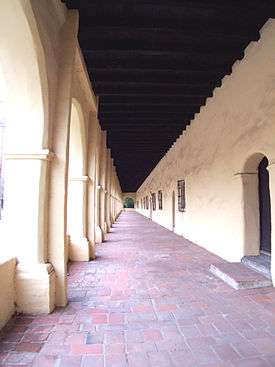Valley Village, Los Angeles
Coordinates: 34°09′54″N 118°23′47″W / 34.16488°N 118.39650°W
| Valley Village | |
|---|---|
| Neighborhood of Los Angeles | |
 Valley Village Location within Los Angeles/San Fernando Valley | |
| Coordinates: 34°09′54″N 118°23′47″W / 34.16488°N 118.39650°W |
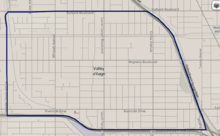
Valley Village is a neighborhood in the city of Los Angeles, located within the San Fernando Valley.
History
Founding
According to Elke Garman, co-president of the Valley Village Homeowners Association in 1991, the history of Valley Village went back to the 1930s, when workers at nearby motion picture studies built houses there. The local post office on Magnolia Boulevard canceled all mail with a "Valley Village" postmark. It was, however, officially a section of North Hollywood.[1]
Separation from North Hollywood
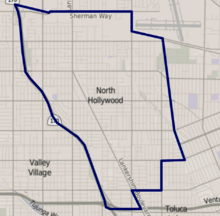
The idea of separating Valley Village from North Hollywood was brought into public light with a meeting of about 300 homeowners at Colfax Avenue Elementary School in December 1985,[2] yet it wasn't until 1991 that Valley Village got seven new blue reflective markers from the city of Los Angeles to mark its borders.[1]
Reporter James Quinn of the Los Angeles Times wrote that Valley Village no longer wanted to be associated with North Hollywood, "a community that has grown old, heavily Latino and crime-plagued," but, in the same article, Valley Village leader Tom Paterson was quoted as saying that the move "was more than an attempt to boost property values" and that it "had nothing to do with ethnic demographics." Rather, he said, "It was one economic level seeking to have its own identity."[3] Quinn wrote that:
Houses along Valley Village's lushly landscaped, graffiti-free streets cost up to $800,000, and a two-bedroom, two-bath entry-level house will run $300,000, residents say. Elsewhere in North Hollywood, that same size entry-level house can be purchased for as little as $150,000, real estate agents say. And the cheaper house is likely to have an overgrown, dusty yard and to be in a neighborhood reeling from crime, with gang graffiti splattered on block walls and street signs.[3]
'Stucco mountains'
In December 1985, some three hundred homeowners gathered at Colfax Avenue Elementary School to begin a campaign to head off development of what they called "stucco mountains" – continued construction of large apartments and office buildings in the area. Councilman Joel Wachs said he would support the drive, although he rejected the details of a proposed advisory panel for the area. He said a proposed panel of homeowners might overlook the concerns of renters and the need for rental housing.[2] Residents complained about blocked views, parking problems and traffic congestion because of buildings as high as five stories next to their single-family homes.[4]
The measure would not have banned construction but would have limited all new buildings to two stories and the square footage of commercial development to 1 1/2 times the size of the lot. The plan had the support of Valley Village resident Tom Paterson, president of the Valley Village Homeowners Association, but the opposition of, for one, Marvin Eisenman, an apartment-building owner who said it would not be fair to landowners who purchased property with the idea of developing it.[5] It was touted as a temporary measure until city planners could conduct public hearings on new, permanent development limits.[6] On September 17, 1986, the City Council approved the idea on a 10-2 vote,[7] but less than a month later it reversed itself after heavy lobbying – by former Councilman Arthur K. Snyder, among others – and sent the ordinance back to committee, with the idea that it could be brought back with exemptions for areas where development had already occurred.[6] Finally, substantially the same measure was approved by the council on a temporary basis with exemptions for two dozen properties in areas where there had already been substantial development, like the south side of Riverside Drive between Colfax Avenue and Laurel Canyon Boulevard.[4]
Eventually, the Los Angeles city Planning Commission recommended that a three-story limit be adopted for the Valley Village area.[8]
Housing
Although in 1994 the Los Angeles Times called Valley Village an "area of upscale residences,"[9] the 2000 census found that renters occupied 68.7% of the housing units, and homeowners occupied the rest.[10] In 2006 Valley Village was described in another article as a neighborhood "mostly of 1,700-foot, single-story Spanish- and ranch-style homes that typically sit on nice-size lots." Most of the 3,881 single-family homes were on residential streets, and 1,073 condos and 8,213 apartment units lined the main boulevards.[11]
Geography
The 2.09-square-mile Valley Village lies north of Studio City, east of Sherman Oaks, and south and west of North Hollywood.
Mapping L.A. describes the Valley Village borders as Burbank Boulevard to the north, the Central Branch of the Tujunga Wash to the east, the Ventura Freeway to the south and Coldwater Canyon Avenue to the west.[10]
 |
Valley Glen | North Hollywood | North Hollywood |  |
| Sherman Oaks | |
NoHo Arts District - CA 170 | ||
| ||||
| | ||||
| Sherman Oaks | Studio City - CA 101 | Toluca Lake CA 134 |
Population
A total of 24,190 people lived in Valley Village's 2.09 square miles, according to the 2000 U.S. census – averaging 11,600 people per square mile, about average for Los Angeles. Population was estimated at 25,665 in 2008. With its percentage of white people considered high for Los Angeles County, Valley Village is still moderately diverse in its ethnic makeup, with a diversity index of 0.512. "The diversity index measures the probability that any two residents, chosen at random, would be of different ethnicities. If all residents are of the same ethnic group it's zero. If half are from one group and half from another it's .50."[12] Whites made up 66.7% of the population, Latinos were 18.9%%, with black people at 5.5% and Asians and others, both at 4.4%.The median age was 36, considered old when compared to the city as a whole.[10] There is a sizable Jewish community.[13]
The $55,470 median household income in 2008 dollars was average for the city and county. The average household size of two people was low for both the city and the county. The percentages of divorced men, divorced women, never-married men and widowed women were among the county's highest.[10]
Education
Schools within Valley Village are:
High schools:
- North Hollywood Senior, 5231 Colfax Avenue, LAUSD
- Oakwood Secondary, 11600 Magnolia Boulevard, private
- Valley Torah, 12517 Chandler Boulevard, private.
Continuation school:
- Amelia Earhart, 5355 Colfax Avenue, LAUSD
Elementary schools:
- Beth Hillel Day, 12326 Riverside Drive, private
- Burbank Boulevard, 12215 Albers Street, LAUSD
- Colfax, 11724 Addison Street, LAUSD charter
- The Country School, 5243 Laurel Canyon Boulevard, private
Parks and recreation
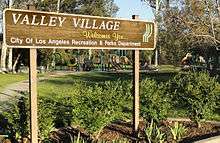
Valley Village Park, an unstaffed pocket park, as well as the North Hollywood Recreation Center, serve the area of Valley Village. The recreation center has an auditorium, lighted indoor baseball diamond courts, lighted outdoor baseball diamonds, lighted outdoor basketball courts, a children's play area, lighted handball courts, picnic tables, an outdoor unheated seasonal pool, and lighted tennis courts. In addition the center has an indoor gymnasium which can be used as a second auditorium and a community room; the gymnasium's capacity is 250 people.[14][15]
Marilyn Monroe house
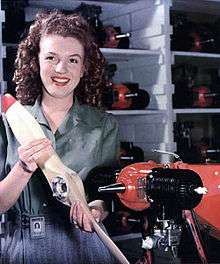
A house at 5258 Hermitage Avenue[16] where film actress Marilyn Monroe lived in 1944-45 under her married name of Norma Jean Dougherty, was demolished by a property developer to make way for a condominium project in June 2015 even as it was under consideration as a historic landmark. She lived there at age 17 while her husband, James Dougherty, was in the Navy, and she had a job inspecting parachutes at a nearby factory. She was living there when she was asked to pose for her first pin-up photo. It was said, however, that the chances of the house being declared a landmark were slim because, as Ken Bernstein, director of the city's Office of Historic Resources, put it, "There are hundreds, if not thousands, of houses associated with celebrities.[17][18] Monroe resided at the property for only one year "and did not live in the unit during the productive period of her career," a report by city planning officials said.[19]
In October 2015 Los Angeles was facing a lawsuit over the house's destruction by a group called Save Valley Village. At issue was the City Council's practice of "automatically heeding the wishes" of the council member who represents any given area in a controversy. The group said it also had "overwhelming evidence" that an environmental report should have been prepared for the condo project. As well, the group asked that the city nullify any development projects that received unanimous support during the previous twelve months.[19]
References
- 1 2 Aaron Curtiss, "Name Changes, Neighborhood Doesn't," Los Angeles Times, February 13, 1991
- 1 2 Marc Igler, "North Hollywood Growth Cap Sought," Los Angeles Times, December 19, 1985
- 1 2 James Quinn, "Most Profound Changes Sweep N. Hollywood," Los Angeles Times, June 14, 1992
- 1 2 Richard Simon, "Council Enacts Building Limits on High-Rises in Valley Village," Los Angeles Times, November 19, 1986
- ↑ Thomas Omestad, "Ferraro Backs Growth Curbs for Valley Village," Los Angeles Times, October 10, 1986
- 1 2 Richard Simon, "Lobbied Council Flip-Flops on Builder Curbs," Los Angeles Times, October 15, 1986
- ↑ Richard Simon, "Council Approves North Hollywood High-Density Limits," Los Angeles Times, September 18, 1986
- ↑ Tracey Kaplan, "L.A. Planners OK 3-Story Buildings in North Hollywood," Los Angeles Times, November 10, 1989
- ↑ Ron Galperin, "What's in a Name? Residents Work to Change Community Names in Effort to Improve Image, Distance Themselves From Troubled Areas," Los Angeles Times, November 6, 1994
- 1 2 3 4 Mapping L.A., Valley Village
- ↑ Diane Wedner, "Village Locals Say It's a Slice of the Sweet Life," Los Angeles Times, January 29, 2006
- ↑ "Diversity," Mapping L.A., Los Angeles Times
- ↑ Roslyn Rozbruch, "New Name Adds Pride to Friendly Town," Los Angeles Times, August 16, 1992
- ↑ "North Hollywood Recreation Center." City of Los Angeles. Retrieved on March 19, 2010.
- ↑ . "Valley Village Park" Retrieved on July 30, 2014.
- ↑ Location of Marilyn Monroe house on Mapping L.A.
- ↑ Dana Bartholomew, "Former Marilyn Monroe House in Valley Village Razed While Poised for Potential Preservation," Los Angeles Dailu News, June 16, 2015
- ↑ Bianca Barragan, "The Valley Village House Where Marilyn Monroe Got Her Start Was Just Demolished," Curbed Los Angeles, June 17, 2015
- 1 2 Emily Alpert Reyes, "Lawsuit Seeks to Block a Condo Project Where Marilyn Monroe Once Lived," Los Angeles Times, October 5, 2015


